MARIANI’S
Virtual
Gourmet
January 25,
2015
NEWSLETTER
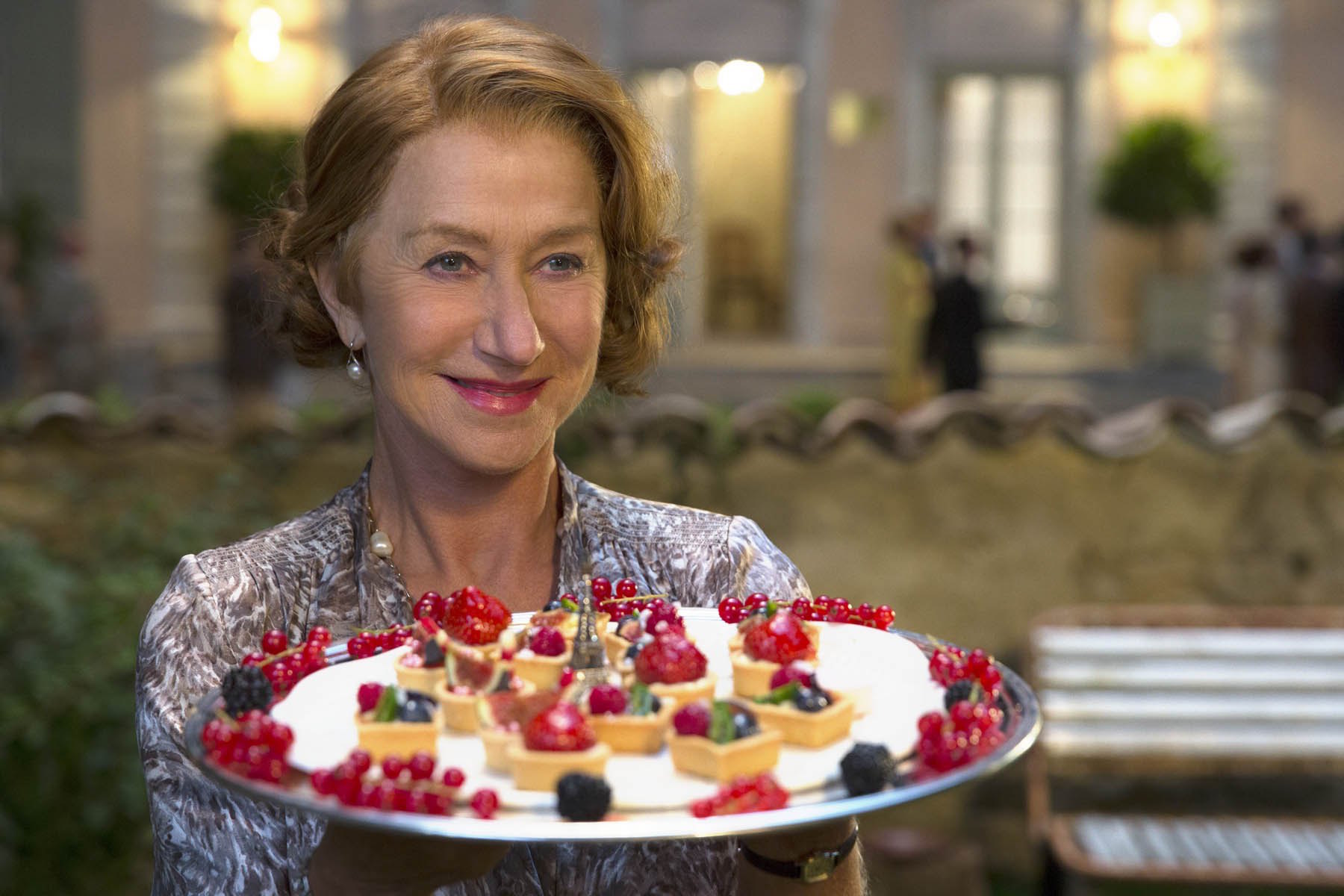
Helen Mirren in "The Hundred-Foot Journey" (2014)
IN THIS ISSUE
STAYING AND DINING IN VIENNA
By John Mariani
NEW YORK CORNER
WHITE STREET
By John Mariani
NOTES FROM THE WINE CELLAR
CRAFTING A MODERN BRUNELLO
By John Mariani
❖❖❖
STAYING AND GUTES ESSEN IN VIENNA
By John Mariani
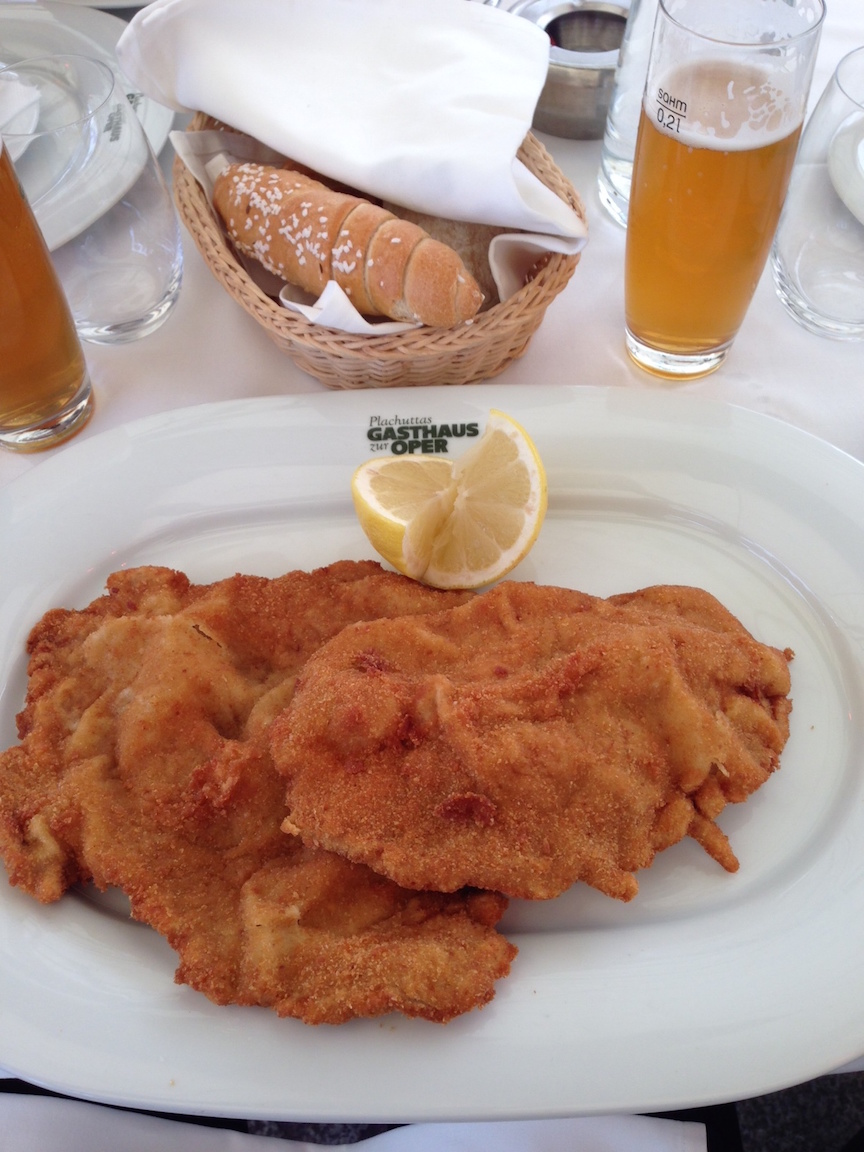
Wiener Schnitzel at Plachuttas Gasthaus zur Oper
Photo by Galina Dargery, 2014
A few words about dining out in Vienna. Just about every restaurant has a menu provided in English. Dress, as everywhere in Europe these days, is casual, but at the more traditional restaurants and cafés you will want to dress a bit conservatively, although bluejeans are everywhere. There is no smoking allowed inside. Service is unfailingly courteous, and in the cafés very efficient; you won't wait more than a minute or two for your order.
As for tipping, I received various answers from various Austrian friends: Many restaurants list a service charge--usually about 10.5 percent--on the bill, along with a 10 percent value added tax (VAT); there may also be an old-fashioned cover charge, which can be a hefty €2-4. The best bet is to ask if service is included and, if it is, just leave another few Euros; if not, a 10-15 percent gratuity is acceptable.
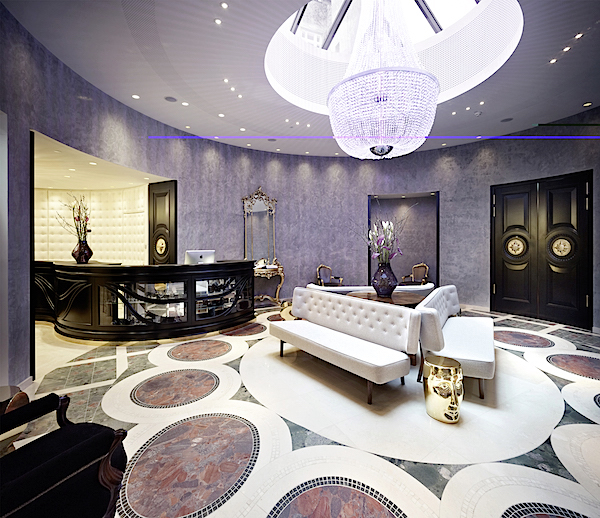 SANS
SOUCI WIEN
SANS
SOUCI WIEN
Burgasse 2
43-1-522 25 20
sanssouci-wien.com
But the inconvenience was handled
with aplomb by the management, who offered coffee, breakfast, anything short of
a room, so we had a lavish buffet breakfast at the
hotel, wandered the city in deep jet lag, returned
to San Souci to have a fine lunch at La
Veranda (right),
then collapsed into bed at one p.m. for a long nap.
The hotel, which in 2010 took
over the site of an old historic inn, is very
modern. Its
circular reception room (above) is done in shades of gray
and lavender, and in parts of the hotel there
is work by Roy Lichtenstein and other contemporary
artists. The spacious, well lighted rooms are all
done in white, each with good views over the
city. A subway
is just a block away; the tram three blocks
away. The service staff, all of whom
speak perfect English, could not have been more
helpful with travel plans around the city. Wi-Fi is
complimentary.
La
Veranda is a small dining room in white, dark brown
and purple, where chef de cuisine Simone Jäger shows
her affinity for a contemporary take on Austrian
cuisine, with a feminine eye for beautiful
presentations. We began with three types of bread
and excellent olive oil, an immediate restorative to
our weariness, followed by an equally inspiriting
beef consommé with noodles and a hearty dish of
goat’s cheese on baked potatoes with a lush
hollandaise. Dumplings
(left) were
treated to herbs, greens and mustard, while veal
with morels came with the unexpected aromatics of
lemongrass, which went very well with a bottle of Pichler
Grüner-Veltliner.
Open daily for breakfast,
lunch and dinner.
EDVARD 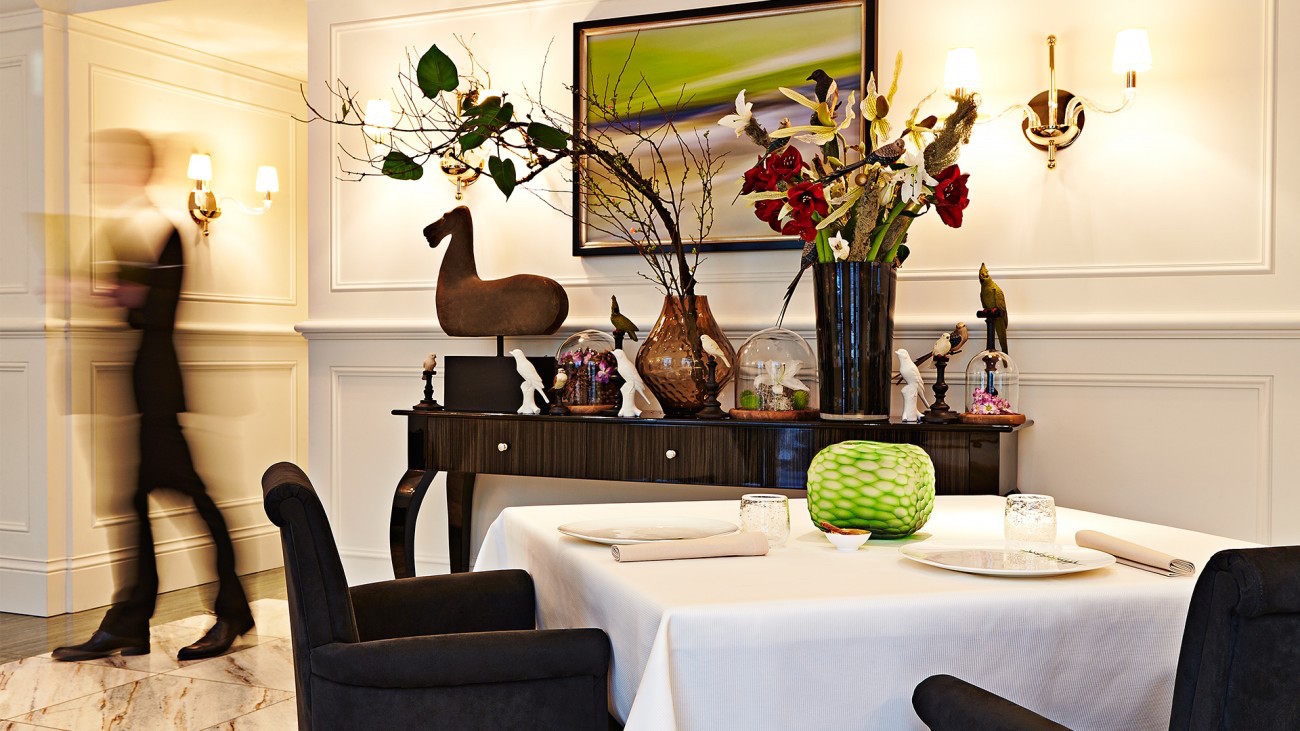
Palais
Hansen
Kempinski Hotel
43-1-236-1000-8082
kempinski.com
The creamy colors, folk art,
and roomy dark brown chairs in the long dining room
make this an exceptionally comfortable place to
dine, the linens thick, the glassware thin, the wine
list deep, especially in Austrian bottlings,
and the hospitality amiably deferential.
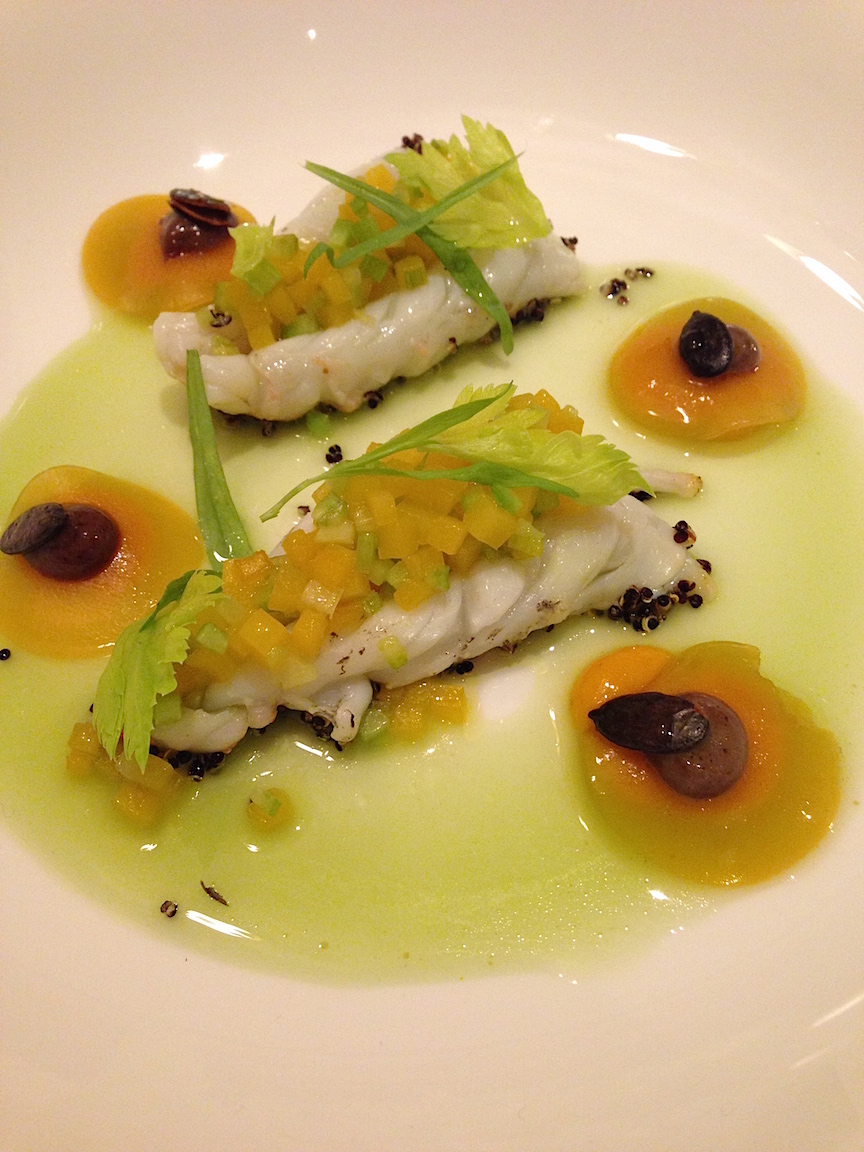 We
began with a dish of small bits of oxtail, celery
and truffle enriched with bone marrow and sourdough
bread (€19),
then enjoyed grilled eel with sushi rice, pickles
and yuzu (€20.50), a
dish that shows Mr. Vogel’s fusionary reach, also
evident in the delicious, succulent lamb with
eggplant, miso,
gyoza and
kombu
kelp ( €39). He does a more traditional take on
local seafood, with pike perch in simple brown
butter with spinach, hazelnuts, lemon and a little
smoked eel (€38.50).
Dry-aged beef--unusual in Europe--is seared
tandoori-style, with beef tendon and cabbage
(€39.50). Such lovely food manages to be both
sumptuous and delicate at the same time.
We
began with a dish of small bits of oxtail, celery
and truffle enriched with bone marrow and sourdough
bread (€19),
then enjoyed grilled eel with sushi rice, pickles
and yuzu (€20.50), a
dish that shows Mr. Vogel’s fusionary reach, also
evident in the delicious, succulent lamb with
eggplant, miso,
gyoza and
kombu
kelp ( €39). He does a more traditional take on
local seafood, with pike perch in simple brown
butter with spinach, hazelnuts, lemon and a little
smoked eel (€38.50).
Dry-aged beef--unusual in Europe--is seared
tandoori-style, with beef tendon and cabbage
(€39.50). Such lovely food manages to be both
sumptuous and delicate at the same time.
Whoever said French toast is just for
breakfast has not had Edvard’s version, with bacon
and maple syrup ( €13.50) as a wonderful dessert,
while a soft nougat comes with citrus, crunchy
granola and marzipan (€12.50).
Although not all men wore
jackets, most gentlemen would, especially since the
staff is so well dressed and mannerly.
Open for dinner Tues.-Sat.
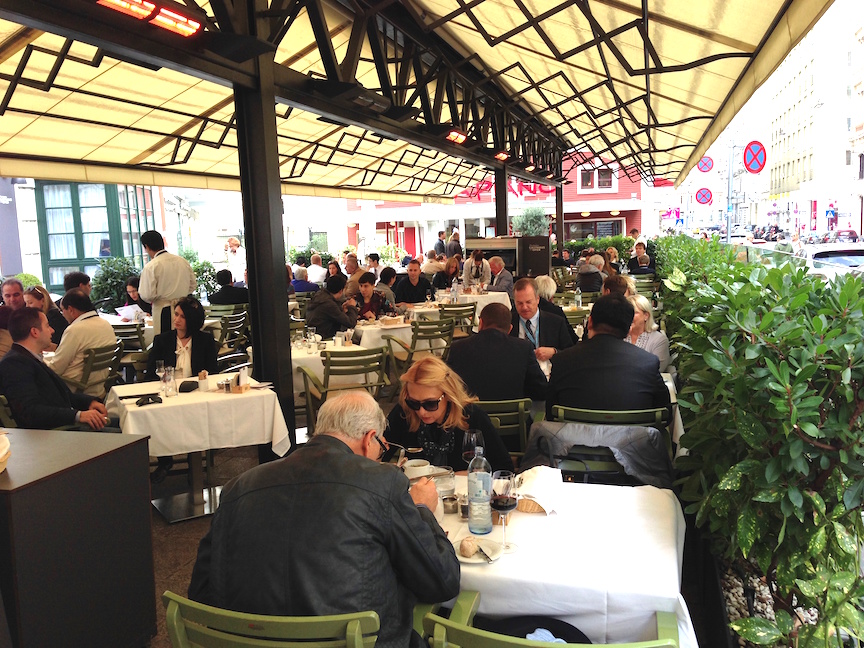
Walfischgasse 57
43-1-51-222-51
plachutta.at/en/gasthaus_zur_oper
Everyone in Vienna has a
favorite places to go for the classic Austrian
Wiener Schnitzel, but few would disagree that the
city’s six Plachutta restaurants have perfected the
dish by serving tens of thousands of them over many
years. (The
recipe is kindly printed with photos in their
brochure.) Legend has it that the dish derives from
costoletta
alla milanese, which Count Joseph Radetzky
fortunately brought back from Lombardy to Vienna in
the mid-19th century.
Having dined on my last trip at
the cozy Plachutta on Wollzeile Street, this time,
on a warm October day, we dined at the Plachuttas
near the Opera House (right). By one o’clock every table was
taken and remained so throughout the afternoon, the
guests all nicely dressed, with many families in
attendance, so that watching the passing parade in
the tented dining area and on the street is part of
the allure here.
A friendly, fleet-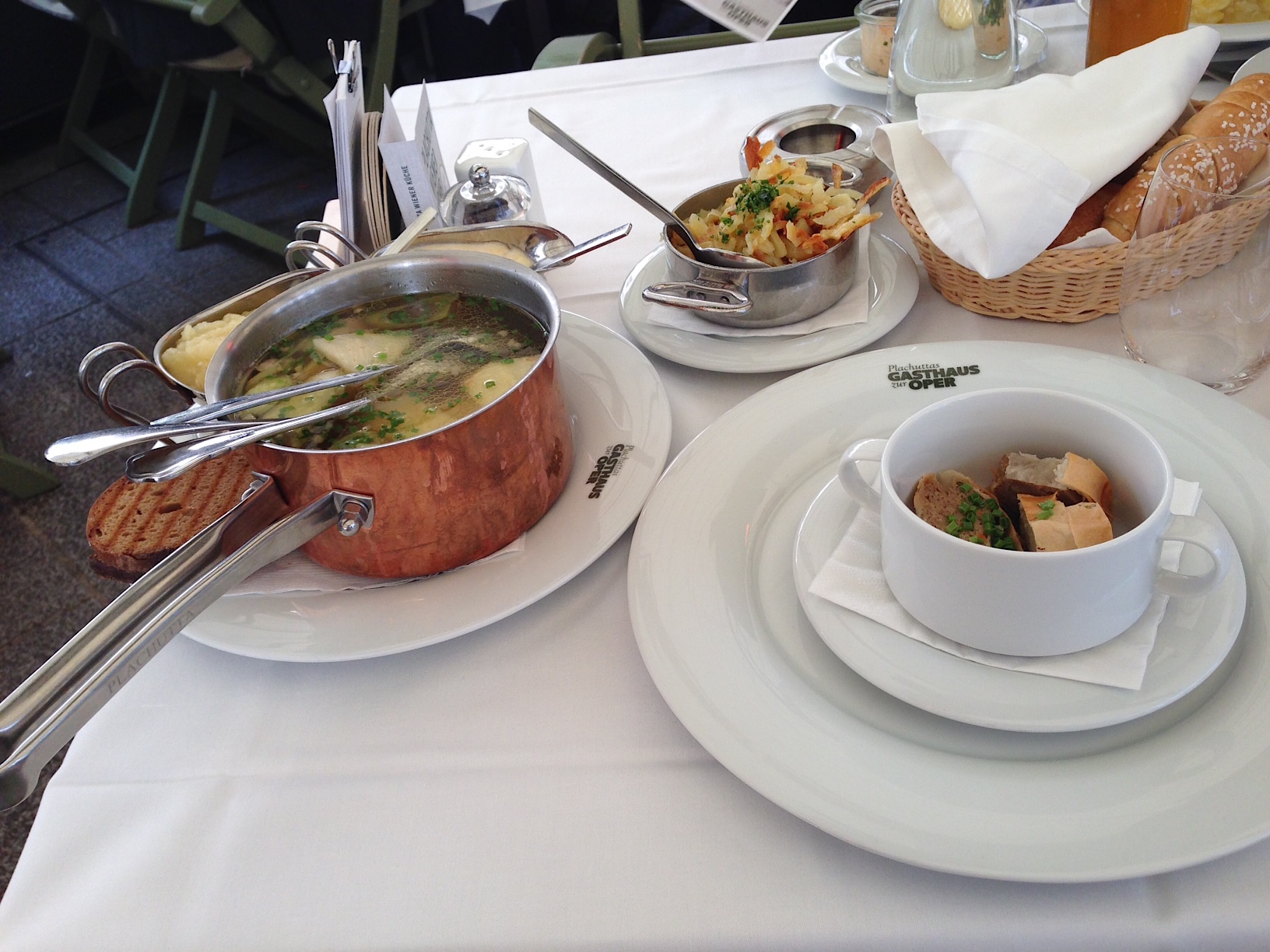 footed server
hands you a menu, knowing full well what you will
order--a glorious, golden Wiener Schnitzel, which
overlaps the plate, its pounded veal breaded and
sautéed to achieve the look of a lunar landscape. A
squirt of lemon is all that’s needed. It crunches on
first bite, then gives way to very tender veal.
footed server
hands you a menu, knowing full well what you will
order--a glorious, golden Wiener Schnitzel, which
overlaps the plate, its pounded veal breaded and
sautéed to achieve the look of a lunar landscape. A
squirt of lemon is all that’s needed. It crunches on
first bite, then gives way to very tender veal.
The ranking alternative here is Tafelspitz (left), a
boiled meat dish in copper casseroles that
begins with its own broth, followed by cuts of
steamy, very juicy Austrian-raised beef shoulder, ox
tongue, brisket and so on (the classic version is
with Hüferschwanzel,
from the rump).
The casserole is more than enough for two
people, served with sour cream and horseradish, but
you’ll probably want to order spinach and the crisp,
buttery spätzle
potatoes.
Everyone at lunch that
day looked very happy, whether because it was an
unusually warm autumn afternoon or simply because a
meal at Plachuttas Gasthaus zur Oper is some of the
greatest comfort food in Europe.
Open daily. Main courses run €20-25.
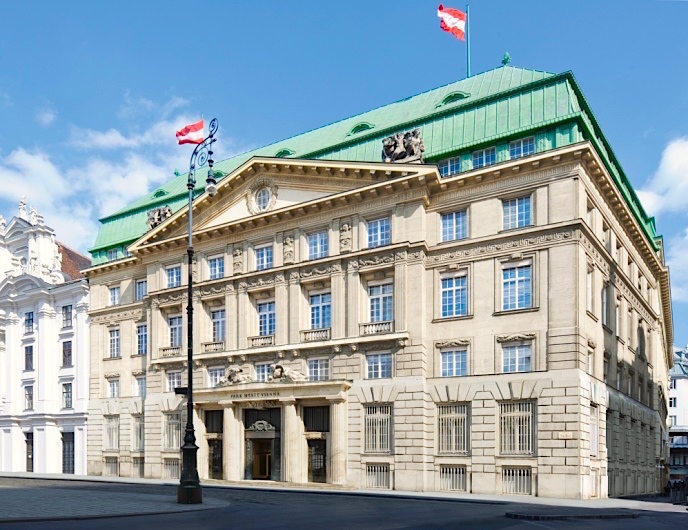
PARK HYATT HOTEL VIENNA
Am Hof 2
43-1-22740 1170
vienna.park.hyatt.com/en/hotel/dining/the-bank
The brand new Park Hyatt hotel
in Vienna--in the skeleton of a century-old bank
building in the
historic center and shopping district--is
already setting a very high standard for modern
luxury. I
did not have the opportunity to stay at the hotel
this time, but could see in every detail of the
public rooms just how luxurious the private rooms
must be, all of them constructed to be larger than
most in the city’s older deluxe hotels. Each of the
143 rooms has a sitting area, and the sixth floor is
comprised of studios with walk-in closets, and all
are equipped with modern bath facilities and
technology. Wi-Fi
is free.
The appropriately named main
dining room is The Bank (the other, more casual room
is named Pearl), a vast space of white marble
with widely separated tables, very comfortable blue
chairs, and a stunning open kitchen (below) that
must stretch 50 feet or more across an elevated
stage that holds a chef's table.
There is a
very beautiful glass counter with Champagne on ice
up front, and large spun glass balls fill in for
shrubbery in elegant pots around the room. I do wish
they had put tablecloths on the table; in a room of
this elegance, however fine bare tabletops may look,
they still lend an off-note of cost-savings to an
otherwise opulent restaurant. Also, the
room's romantic ambiance is not one that needs the
piped-in music after 9 p.m.
There were a few service lapses
in course timing and wine pouring on a Sunday
evening, but the professionalism of the young staff
ran from manager through waiters and the sommelier,
who oversees an extremely impressive list with every
Austrian bottling you could ask for.
The well-priced menu aims at
pleasing the kinds of global guests the hotel
attracts, so, while there are Austrian items on it,
you will also find a very creamy burrata
with Austrian ham, tomatoes and basil (€9) that
makes for a terrific starter. Choggia beet salad
(right)
comes with small balls of goat’s cheese, black
walnuts and rowanberries (€12). Calf’s
liver “Berlin style” with crispy onions and braised
Gala apple (€20) was deliciously appended with a
chive puree and served in a huge portion. For
fall, there was a lusty pan-fried venison ragoût
with potatoes (€32).
beet salad
(right)
comes with small balls of goat’s cheese, black
walnuts and rowanberries (€12). Calf’s
liver “Berlin style” with crispy onions and braised
Gala apple (€20) was deliciously appended with a
chive puree and served in a huge portion. For
fall, there was a lusty pan-fried venison ragoût
with potatoes (€32).
A seven-cheese
cart of unpasteurized Austrian regional artisanal
offerings was a thing to applaud, showing the
country’s diversity in dairy products. Among the
desserts, an unusual and very good poppyseed soufflé
was lavished with vanilla ice cream and plums
braised in Port, which we enjoyed with two different
tröckenberenauslesen dessert wines from that superb
list.
It is obviously an excellent
venue for a business lunch or romantic dinner, and
it's satisfying to know you can eat this well on a
Sunday night in Vienna.
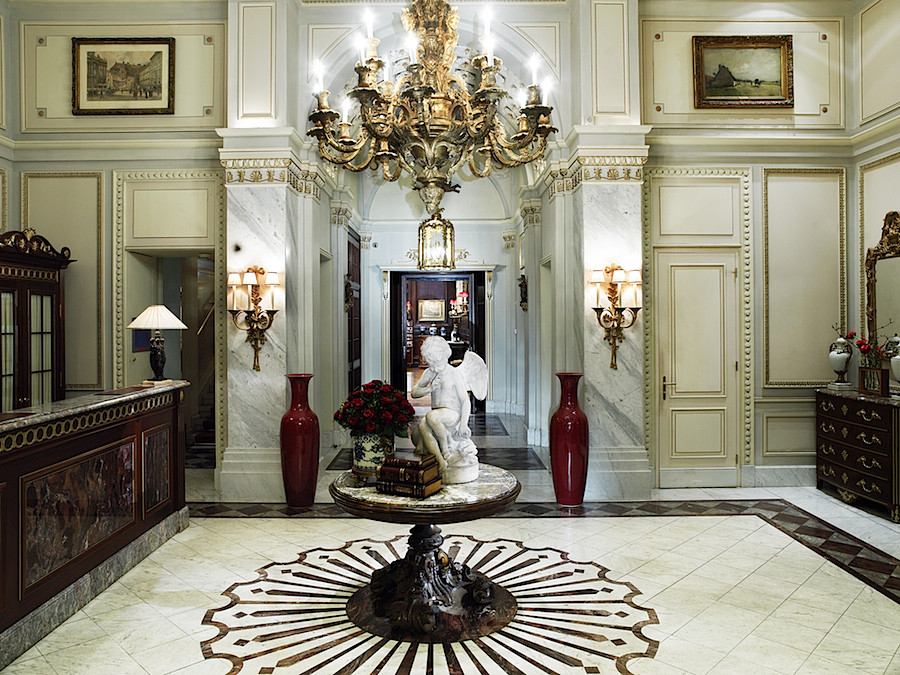 Hotel
Sacher
Hotel
Sacher
Philharmonikerstrasse
43-(1)-51456 840
sacher.com/hotel-sacher-vienna
Founded in 1876 by Eduard
Sacher, though appearing to have opened just
yesterday, the Hotel
Sacher is a marvel of
gleaming Old World charm. For
decades it was run by Sacher’s wife, Anna, who
declared herself "Master in the house” and also
reigned over an entire kennel of pet dogs. Since
1934 the hotel has been run by the Gürtler family,
and their commitment has been to keep every detail
and every square inch of the hotel in museum
quality.
Smack in the city center, the hotel is mere
blocks from just about everything you want to see.
It is opposite the Opera House, near the
marvelous pedestrian shopping area Kärntner Strasse
and St. Stephen’s Cathedral, and a stroll from
the Hofburg Imperial Palace and the
Ringstrasse. For obvious reasons, the Sacher has
been the first choice of visiting celebrities,
royalty, and artists, including Indira Gandhi,
John F. Kennedy, Leonard Bernstein, Herbert von
Karajan, and hundreds more whose photos line the
walls of the Sacher's rooms and hallways. Joseph
Cotton's character Holly Martins in the film "The
Third Man" stayed at the Sacher.
As antique as it
looks, the Sacher is very much up to date—every room
was renovated over the past decade—now with every
modern amenity, from flat screen international TV
and high-speed Internet access and Wi-Fi to
individually controlled air-conditioning and free
use of the fitness facilities and spa.
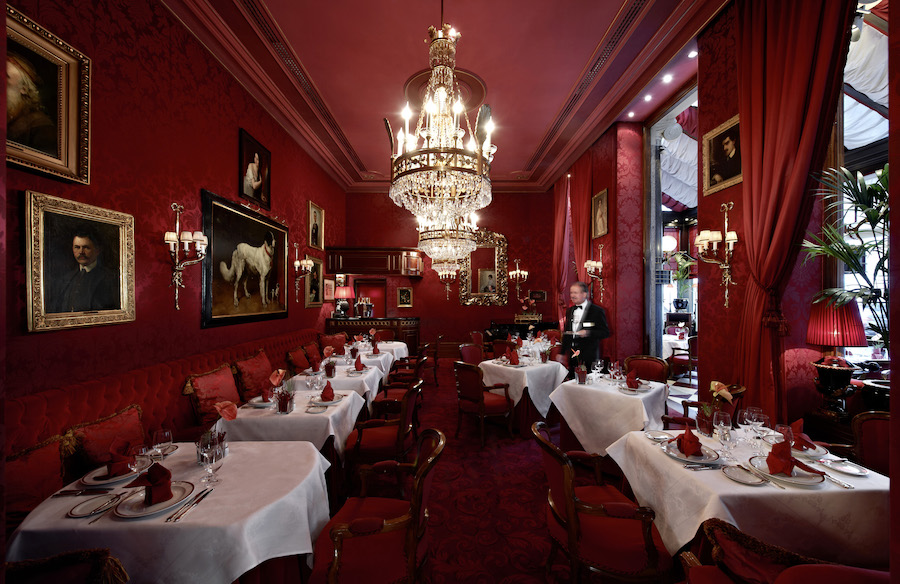
There are two principal dining rooms at
the Sacher. The baronial Rote Bar (left) is
handsomely decked out with deep red brocade walls,
chandeliers, banquette tables, and antique
paintings, all with a view over the city, Here the
menu is definitely Viennese, including dishes like a
good liver tart with elderberry chutney, quince, and
the crunch of hazelnuts in golden, buttery brioche;
Wiener
Schnitzel, of course, with parslied potatoes,
as well as the similar Wiener
Backhander, made with pounded, battered
chicken instead of veal, served with lamb's lettuce
salad.
The other dining room is named Anna Sacher (below), done in
a velvety, deep forest green, with crystal
chandeliers, exquisite mahogany woodwork, and fine
culinary artwork.
The linens are thick, the signature
silverware heavy. When my wife and I dined there,
the room was full of a range of Viennese and guests
from the U.S. and Great Britain, all feeling quite
comfortable within the posh that surrounds them
while never sensing an iota of pretense from the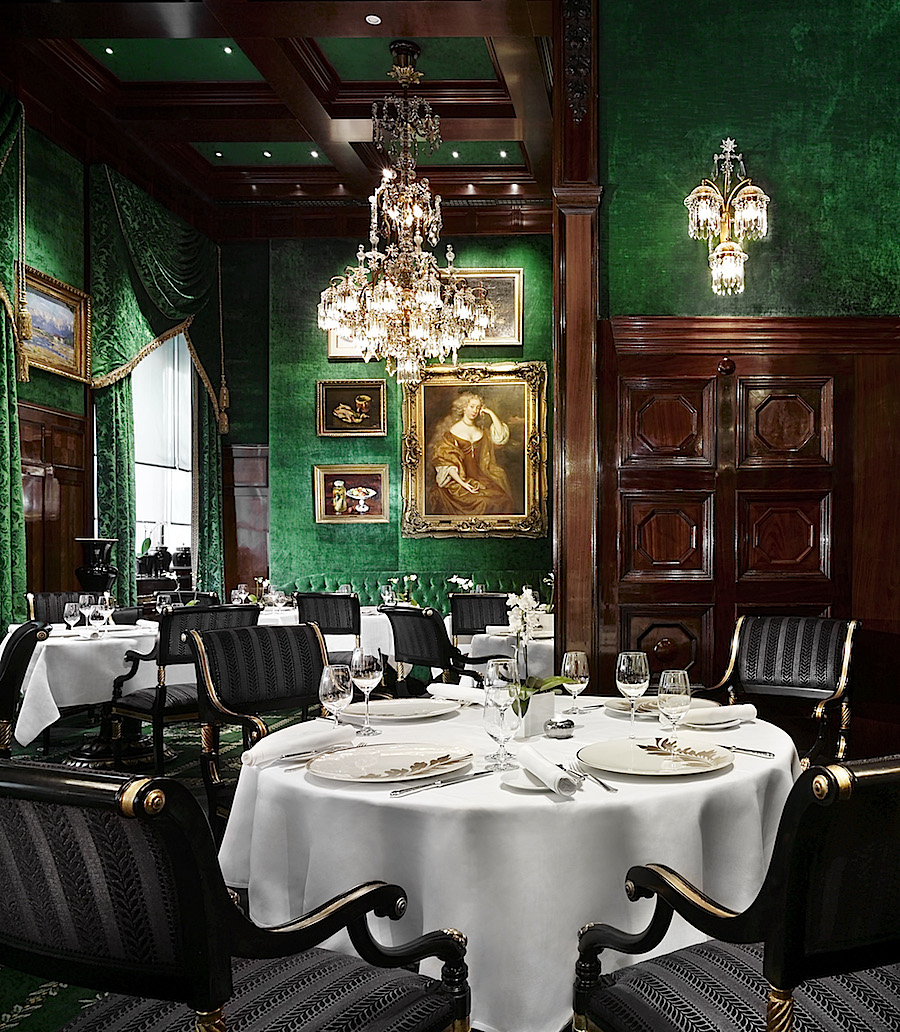 marvelously
orchestrated staff, under manager Christian Fox and
Chef Werner Piclmaier.
marvelously
orchestrated staff, under manager Christian Fox and
Chef Werner Piclmaier.
There is a page on the menu of à
la carte “Viennese Tales”--more traditional
dishes--or four- to six-course menus. We began our
meal with cold marinated goose liver with salsify
and chestnuts that set the tone of the autumnal
repast to follow.
There were two soups, a minestrone of
suckling pig with eggplant, dusted with oregano, and
a rich, creamy Jerusalem artichoke scented with
orange and vanilla.
The seafood
courses were trout with yogurt, sweet potatoes,
scallops, clams and cuttlefish along with poached
codfish with luscious bone marrow, parsley and a
more luscious poached egg. Sheatfish (a species of
catfish) was accompanied by romana
pepper and lemon tartar. Next came a loin of venison
with cèpe mushrooms, hazelnuts and a ragoût of
venison. With this we drank a superb 2011 by
Wieninger, Stammersdorf Pinot Noir Select.
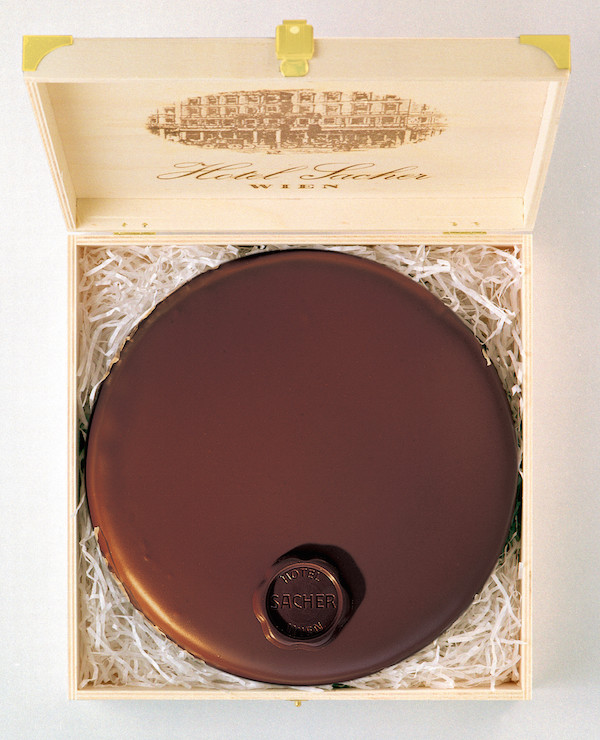 There was a
wonderful assortment of cheeses, including a young
but ripe ewe`s milk from Kaernten as well as
Époisse, Munster and Roquefort, followed by the
inevitable Sacher Torte (left), truly one of the world's
finest chocolate layered cakes, whose story dates to
1832, when Franz Sacher, a 16-year-old
apprentice at the court of Prince Metternich, was
asked to create a special dessert for distinguished
guests. (You can purchase the cake at the Sacher's
restaurants or at one of the four Sacher shops
or at the Confiserie in Vienna, Salzburg, Graz or
Innsbruck. It may also be shipped to you by going to
www.sacher.com/en-original-sacher-tart.)
There was a
wonderful assortment of cheeses, including a young
but ripe ewe`s milk from Kaernten as well as
Époisse, Munster and Roquefort, followed by the
inevitable Sacher Torte (left), truly one of the world's
finest chocolate layered cakes, whose story dates to
1832, when Franz Sacher, a 16-year-old
apprentice at the court of Prince Metternich, was
asked to create a special dessert for distinguished
guests. (You can purchase the cake at the Sacher's
restaurants or at one of the four Sacher shops
or at the Confiserie in Vienna, Salzburg, Graz or
Innsbruck. It may also be shipped to you by going to
www.sacher.com/en-original-sacher-tart.)
Anna Sacher is a place for those
who know and truly love fine dining to bask in its
radiance, and for those who need an introduction to
that world, Anna Sacher is a three-hour education in
elegant, increasingly rarefied, dining.
Restaurant Anna Sacher is open for dinner
Tues.-Sun. A four-course menu is €64, five courses
€76 and six courses €86, with wine options
additional. The
Sacher is holding a gala five-course dinner for
€355 before the Opera
Ball on February 12th.
Hotel
Imperial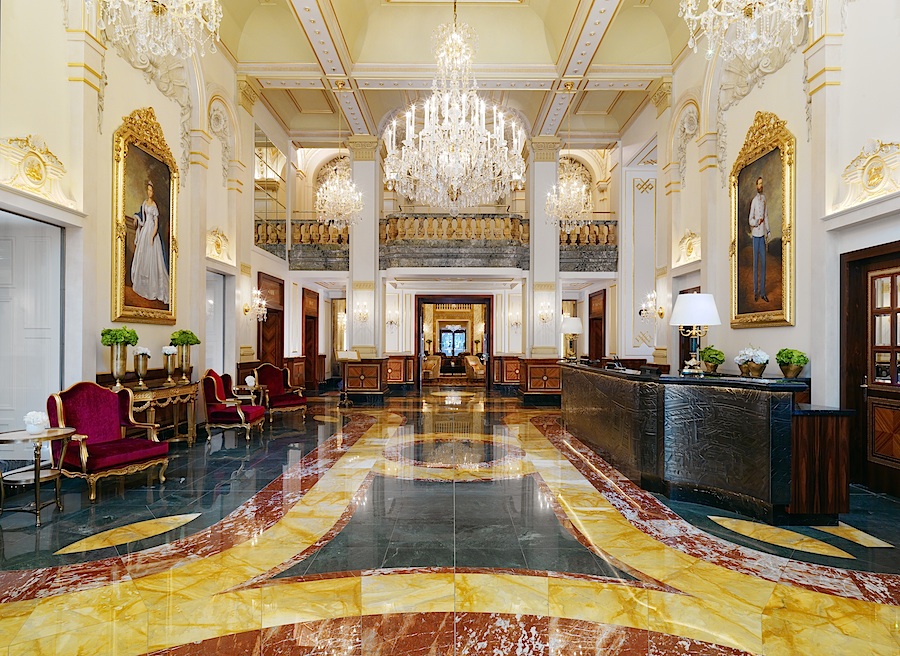
Karntner Ring 16
43-1-501-100
http://www.imperialvienna.com
“Magnificence” is not a word someone in my
profession should throw around with abandon, for
true magnificence is meaningful only on those rare
occasions when expectations are not just met, not
just exceeded but superseded by a totality of
details that produce a kind of awe.
That was what I felt when I
walked into the lobby of the Hotel Imperial, built
in 1863 as the Italian Neo-Renaissance residence of
Duke Philip of
Württemberg and Duchess Marie-Thérèse, whose
portraits flank the lobby. The
Duke was notorious for his fiscal profligacy,
however, so he sold the place five years later,
and five years after that it was transformed for
the city’s Universal Exhibition into the Hotel
Imperial. Ever since, under various owners and
through two world wars, the hotel (now under the
Starwood aegis) has been, along with the Sacher, a
haven for a clientele often of imperial stature,
along with the usual slew of artists and actors
who would never think to stay elsewhere.
 The
hotel's original portal was wide enough for a
two-horse carriage to enter with ease. The Emperor
of Japan has stayed here, as has Queen Elizabeth II
(right),
who brought her own bed to the royal suite so that
no guest afterward could ever claim he’d slept in
the queen’s bed.
Of course, just as the Sacher has its
signature torte, so does the Imperial, whose
confection is a chocolate truffle cake created back
in 1873; the pastry chef will happily personalize it
for you.
The
hotel's original portal was wide enough for a
two-horse carriage to enter with ease. The Emperor
of Japan has stayed here, as has Queen Elizabeth II
(right),
who brought her own bed to the royal suite so that
no guest afterward could ever claim he’d slept in
the queen’s bed.
Of course, just as the Sacher has its
signature torte, so does the Imperial, whose
confection is a chocolate truffle cake created back
in 1873; the pastry chef will happily personalize it
for you.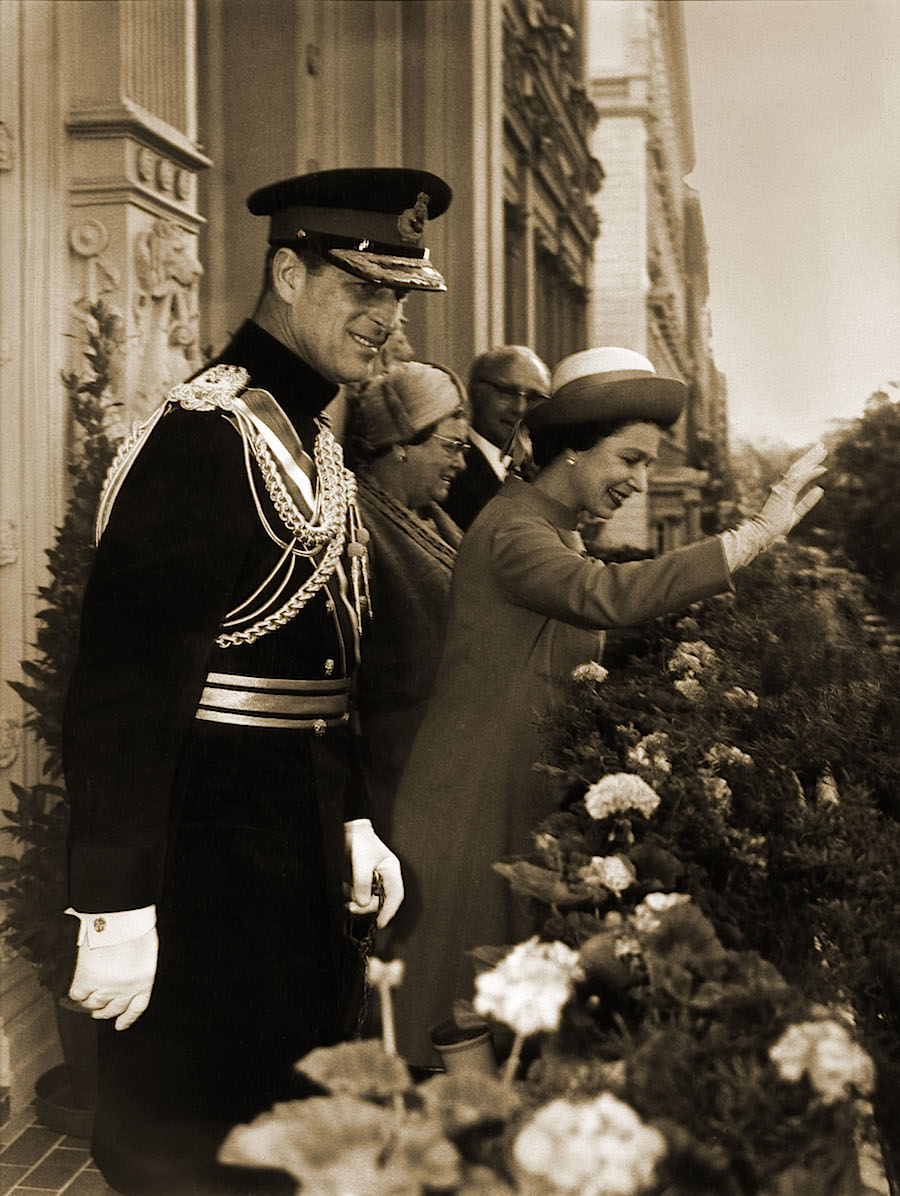
After we checked in at the long marble-topped
reception counter manned by veteran concierges, we
were led up the Royal Staircase that leads to a
series of extraordinary hallways of balustrades and
parapets, thick embroidered carpets and tall mirrors
with gilded frames, all illuminated by crystal
chandeliers. Guest
rooms are furnished with modern bedding, sofas, and
carpeting for which every thread count, every inch
of velvet and brocade, every corner of bathroom
marble is of the finest. Butler service is available 24
hours a day; Wi-Fi is free.
The
public rooms downstairs are some of the most
beautiful in Vienna, not least the bar at the
spacious 1873 HalleNsalon with its clef note
motif and exquisite parquet floors. There are two
restaurants in the 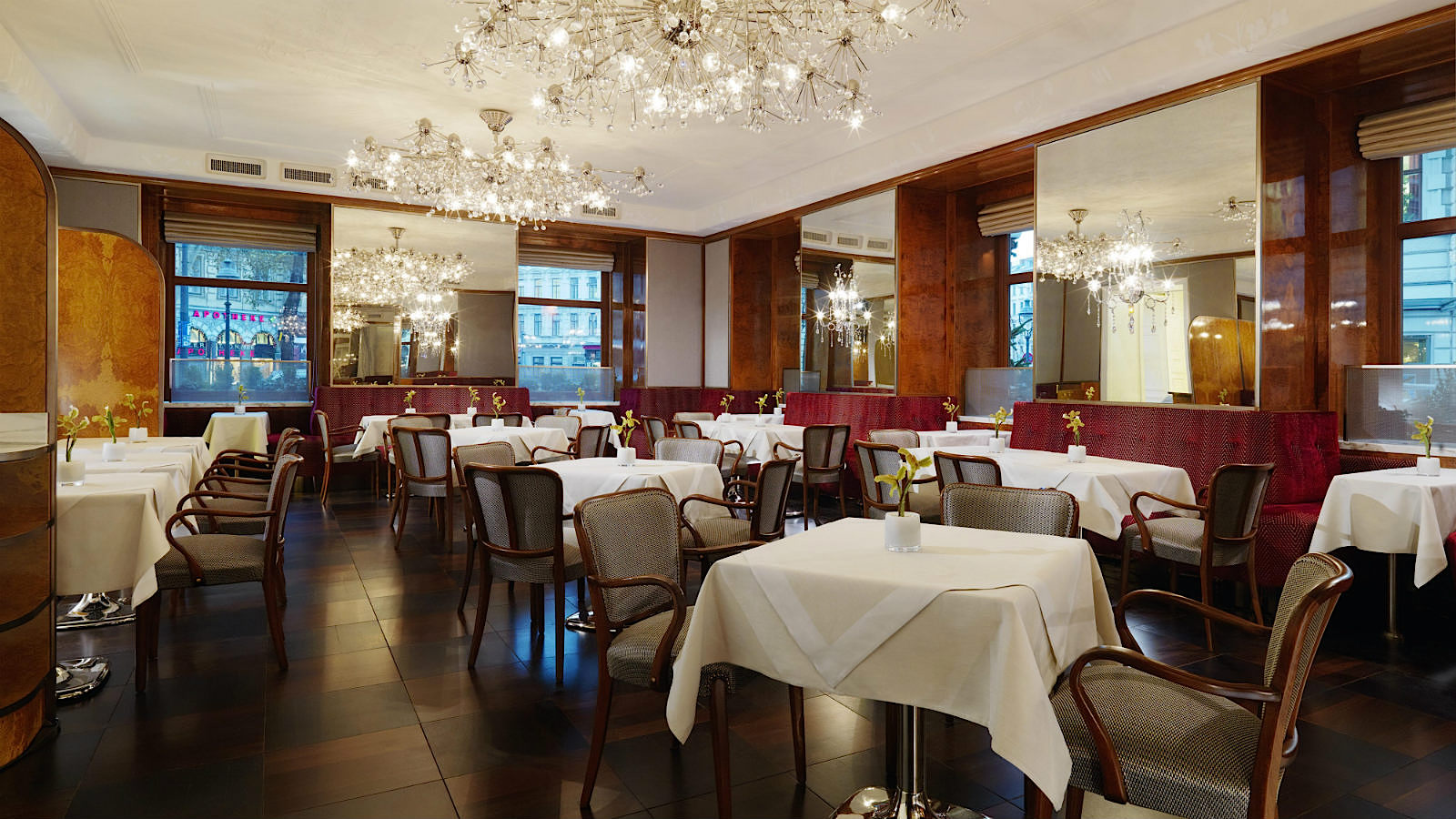 hotel, a fine
dining restaurant named Opus we hadn’t a chance to
try, and the Café
Imperial Wien (left), open for a lavish
breakfast, lunch or
dinner, where we took our last meal in Vienna
in a beautiful, sunny room of mirrors and maple
wood, with
very comfortable Secessionist-style bentwood chairs,
a room that has seen its share of artists, musicians
and littérateurs over the past century.
hotel, a fine
dining restaurant named Opus we hadn’t a chance to
try, and the Café
Imperial Wien (left), open for a lavish
breakfast, lunch or
dinner, where we took our last meal in Vienna
in a beautiful, sunny room of mirrors and maple
wood, with
very comfortable Secessionist-style bentwood chairs,
a room that has seen its share of artists, musicians
and littérateurs over the past century.
Since it
was our last meal in town, I ordered my last Wiener
Schnitzel, wondering if I’d ever find its like again
outside of Vienna.
And, dying for some pasta, I enjoyed fresh
fettuccine with butter, cream and Austrian ham,
along with a bottle of Austrian wine, a 2001
Zweigelt Weingut Pasler from Burgenland.
My wife and I
lingered over the last morsel of the Imperial
Torte and strong coffee, so well contented that the
sadness in leaving Vienna was softened by the city’s
sunlight in the café and by the distant clang of the
tram outside our window.
❖❖❖
By John Mariani
WHITE STREET
221 WEST BROADWAY (near White Street)
212-WHITE-ST (212-944-8378)
whitestreetnyc.com
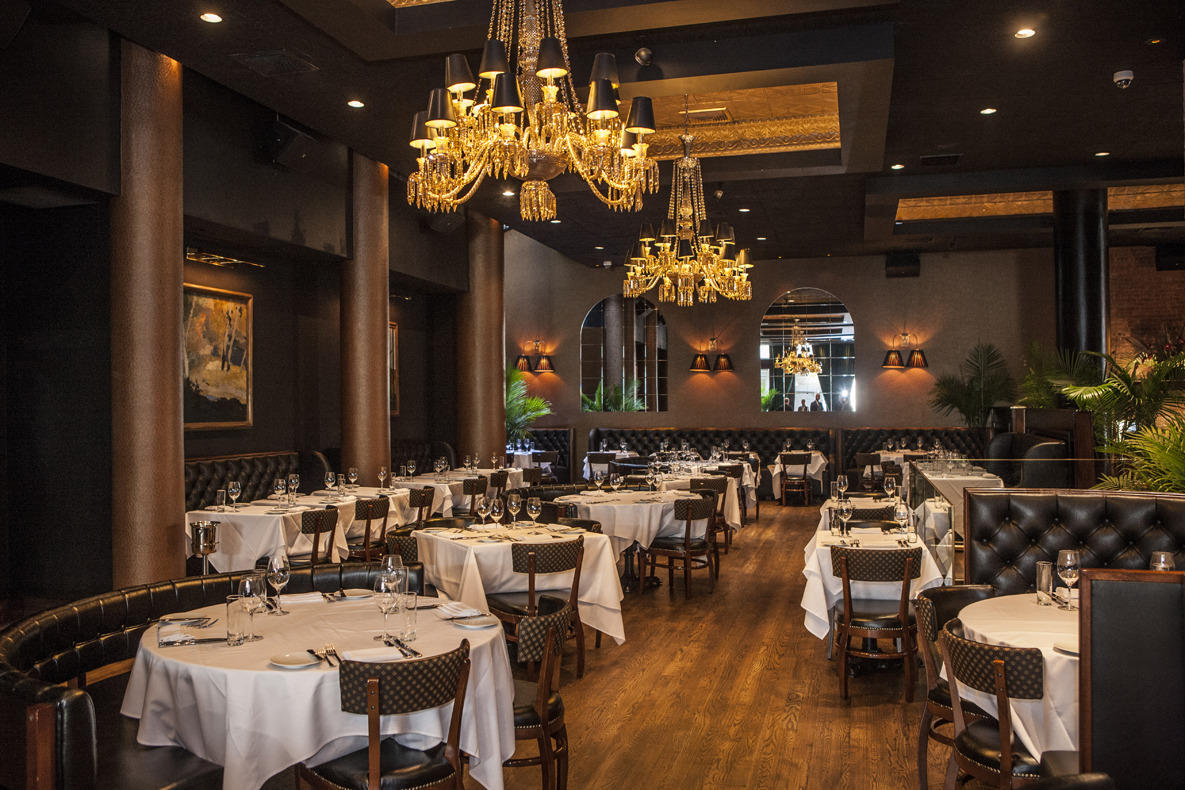 There
are
a few chefs in New York with talents equal to
those of Floyd Cardoz (below), but none cooks quite the
way he does.
He uses a wide-ranging flavor palette to
tantalize the physical palate, and the results can
be stunning. Trained
in Mumbai back when it was Bombay, Cardoz
apprenticed at the Taj Mahal Intercontinental Hotel, then
furthered his global studies in Switzerland before
moving to NYC, where he worked under Chef Gray
Kunz at Lespinasse, then, with restaurateur Danny
Meyer, opened the widely admired Tabla in 1998.
There
are
a few chefs in New York with talents equal to
those of Floyd Cardoz (below), but none cooks quite the
way he does.
He uses a wide-ranging flavor palette to
tantalize the physical palate, and the results can
be stunning. Trained
in Mumbai back when it was Bombay, Cardoz
apprenticed at the Taj Mahal Intercontinental Hotel, then
furthered his global studies in Switzerland before
moving to NYC, where he worked under Chef Gray
Kunz at Lespinasse, then, with restaurateur Danny
Meyer, opened the widely admired Tabla in 1998.
A cookbook, One Spice,
Two Spice, was inevitable, marrying Indian
spices and flavors to global dishes, and when
Tabla closed after a long run, Meyer appointed him
chef at the downtown North End Grill, where,
by giving so much of his time to charities,
he won the 2007 “Humanitarian of the Year” award
from Share Our Strength, a charity that fights
hunger in children.
Cardoz’s cuisine has always been his alone,
but at his new place, White Street in Tribeca,
everything seems refined by his long tenure as
this country’s leading Indian-American chef. The
subtleties of his cooking make perfect sense
within the context of his experience and
background, while appearing thoroughly modern
without ever struggling to be Modernist.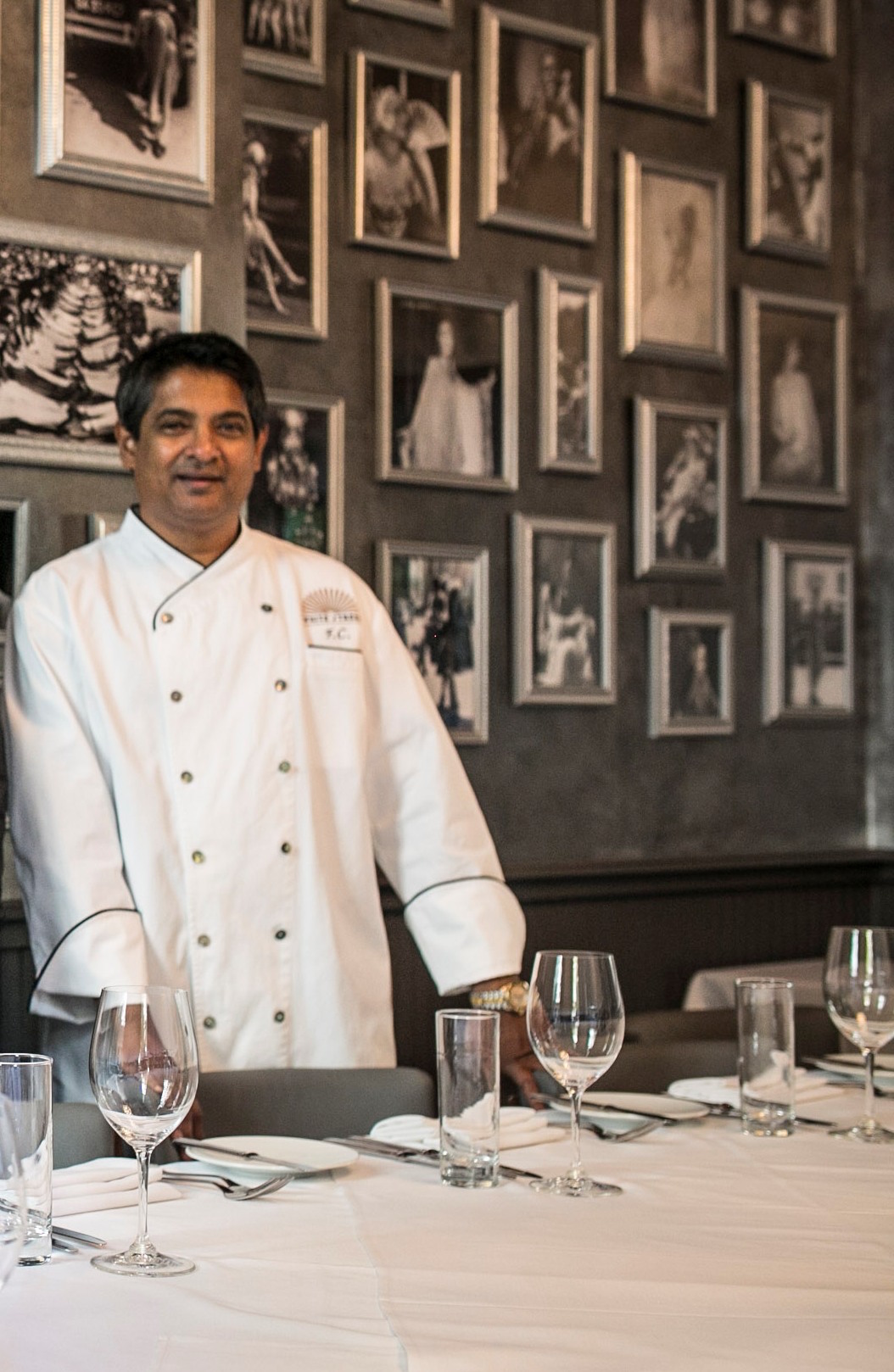
This
grand space used to be a Brazilian steakhouse, and
the new design retains its stately columns, with
gorgeous crystal chandeliers that throw just the
right amount of light on white tablecloths and
tufted banquettes; some fine artwork and mirrors
open up the room even more. The sound level when I
visited on a midweek night was just fine, though I
suspect that may not be so on weekends.
Along
with chef de cuisine Justin Lawless, Mr. Cardoz offers
a
rationally sized
menu of a dozen appetizers ($14-$29) and ten
entrees ($26-$56,
this last
price
for roast chicken for two). Our
table began with roasted cauliflower, broccoli and pumpkin
salad with cider vinegar and maple syrup whose
sour-sweet flavors buoyed the vegetables. Sashimi
of fluke took on added interest
from hackleback caviar and mild uni, with nori seaweed,
citrus and
wasabi, though the strength of last did nothing
for the delicacy
of the fish roe and vice versa.
The last of
the season’s Peconic Bay scallops were lightly
seared and served with orange, fennel and
coriander, while tuna poke came with briny sea
vegetables, toasted coriander, tamari and
the sensuous
melting of the yolk of a quail’s egg. Still among
the appetizers, there was grilled duck breast with
a lovely confit
of endive, crisp pecans, orange and sauce
gribiche, a
small marvel of
crisp textures and citric tang. Bucatini noodles
were lavished with fresh squid ink and
mixed with crabmeat and the surprise of coconut
milk. But the very best of
all was a silky cauliflower soup with a dollop of
swirled lemon-flavored
yogurt and crunchy cashews (below).
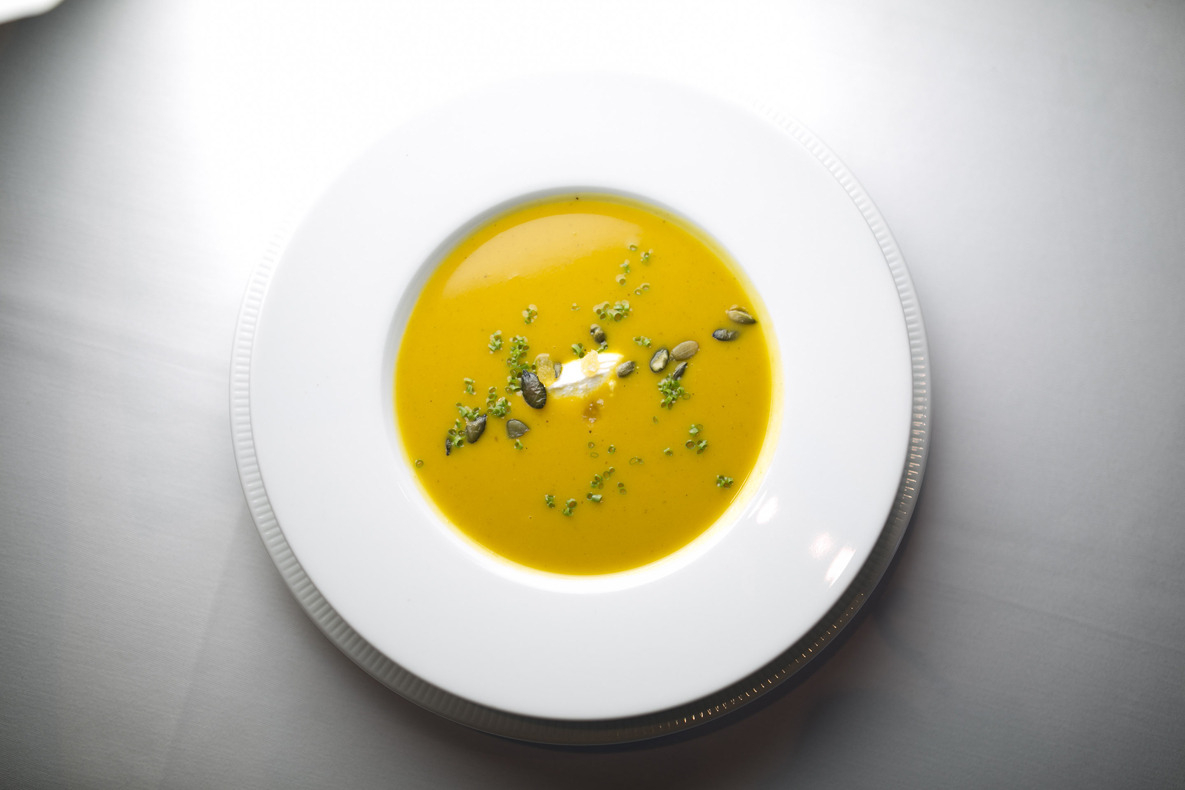 It should be
obvious by now that these East-West marriages of
flavors and
textures are quite new, always subtle, never
clashing. They
are savory
and aromatic, dependent on a deft balance that
other Indian food around town so often lacks. The
same is true of main courses like the rice-crusted sea bream
with kimchi,
shrimp flakes, and a basmati rice cake in
lentil broth;
and a duo of lamb with root vegetables, pine nuts,
and apricot-mustard
sauce—each
with such distinctive nuances. Already
Mr. Cardoz’s
glazed short ribs of beef ribeye with oat risotto,
horseradish and
shoe string potatoes has become a dish
much raved about, and I’ll add my kudos.
It should be
obvious by now that these East-West marriages of
flavors and
textures are quite new, always subtle, never
clashing. They
are savory
and aromatic, dependent on a deft balance that
other Indian food around town so often lacks. The
same is true of main courses like the rice-crusted sea bream
with kimchi,
shrimp flakes, and a basmati rice cake in
lentil broth;
and a duo of lamb with root vegetables, pine nuts,
and apricot-mustard
sauce—each
with such distinctive nuances. Already
Mr. Cardoz’s
glazed short ribs of beef ribeye with oat risotto,
horseradish and
shoe string potatoes has become a dish
much raved about, and I’ll add my kudos.
Alexander
Zecena’s desserts ($12) stay the course, from a
sticky toffee
pudding
with crème fraîche sorbet to lighten the
sweetness, pecan macaroons
and a coconut tuile, to a malted milk chocolate
and vanilla sundae
that
becomes something wholly contemporary with the
addition of a chocolate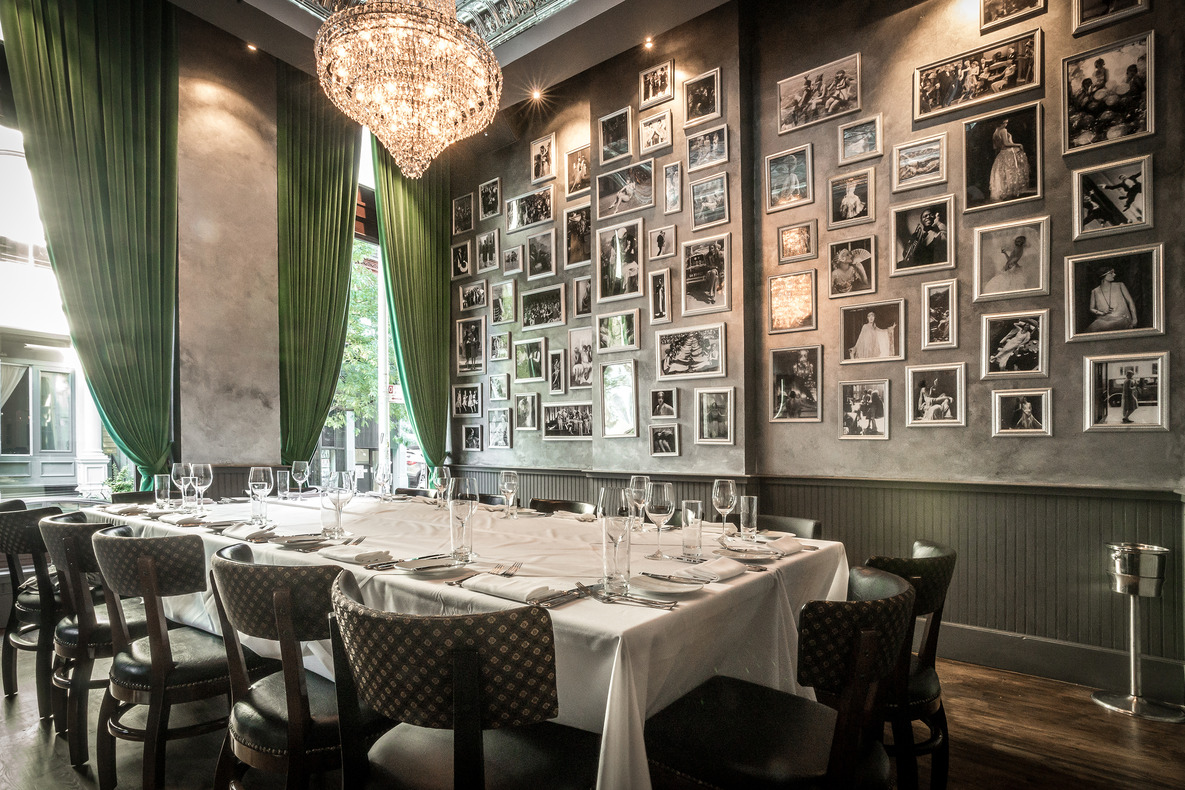 almond
cake, roasted white chocolate and caramel sauce.
almond
cake, roasted white chocolate and caramel sauce.
The wine list at White Street,
overseen by the very knowledgeable and affable
Rebekah Kennedy, is striking for its comprehensive
breadth and depth, though it’s overloaded with
bottles well above $100 and little much
under $80. Wines
by the glass are high mark-ups: Au Bon Climat 2011 is $14
per glass, but a whole bottle will run you $20 in
a wine shop.
There
are so many reasons to be excited by White Street,
most of all for what Mr. Cardoz is cooking but
also for an atmosphere in this neighborhood that
awards the guest with spaciousness, color, and
hospitality more in the mold of Tribeca Grill than
the brash noisiness of Locanda Verde.
Word
is Mr. Cardoz is opening a restaurant in India and
one day another, more traditional one in NYC,
enterprises I hope don’t take him away from White
Street too much.
For now, his is a unique restaurant in the
city and sure to be copied by lesser hands.
By John Mariani
CRAFTING A MODERN BRUNELLO DI MONTALCINO
 Back in
1975 only 800,000 bottles of Brunello di
Montalcino were produced by 25 estates; in 1995
more than 3.5 million bottles were made by 120
estates. Today there are more than 220 estates
producing more than 7 million bottles of this
once rare Tuscan wine. About 60% of Brunello is exported,
with 25% going to the U.S. market since the
mid-1990s. Only about 20 percent is consumed
locally around the town of Montalcino in
Tuscany.
Back in
1975 only 800,000 bottles of Brunello di
Montalcino were produced by 25 estates; in 1995
more than 3.5 million bottles were made by 120
estates. Today there are more than 220 estates
producing more than 7 million bottles of this
once rare Tuscan wine. About 60% of Brunello is exported,
with 25% going to the U.S. market since the
mid-1990s. Only about 20 percent is consumed
locally around the town of Montalcino in
Tuscany.
Traditionally, Brunellos were wines made to
be saved for decades before coming into full
maturity. Legendary bottlings like those of
Biondi-Santi, which created the wine’s reputation
in the 19th century, tasted better at
50 years of age than at 20. But
Brunello’s fame and demand have caused so many
newcomers to plant estates in and around
Montalcino that that old style has been
transformed into several styles, most lighter,
some with more alcohol.
By far the largest investor in Brunello has
been Castello Banfi,owned by the Mariani family
(for the hundredth time: no relation to this
writer), which in 1978 began developing vineyards
around Montalcino—-now with 7,100 acres--financing
ampelographic research to choose the 15 best,
healthiest clones out of 650, information they
shared freely with their competitors.
Castello Banfi last week held a
fascinating seminar in New York at Armani
Ristorante, a tasting that showed how the
components of wines made from grapes grown in
different vineyards on the Banfi property (below) are
knit together by winemaker general manager Enrico
Viglierchio into a number of different wines made
from the sangiovese grape.
As was pointed out at the tasting, led by
Banfi CEO Cristina Mariani, Montalcino is a very
hot region during the day but the 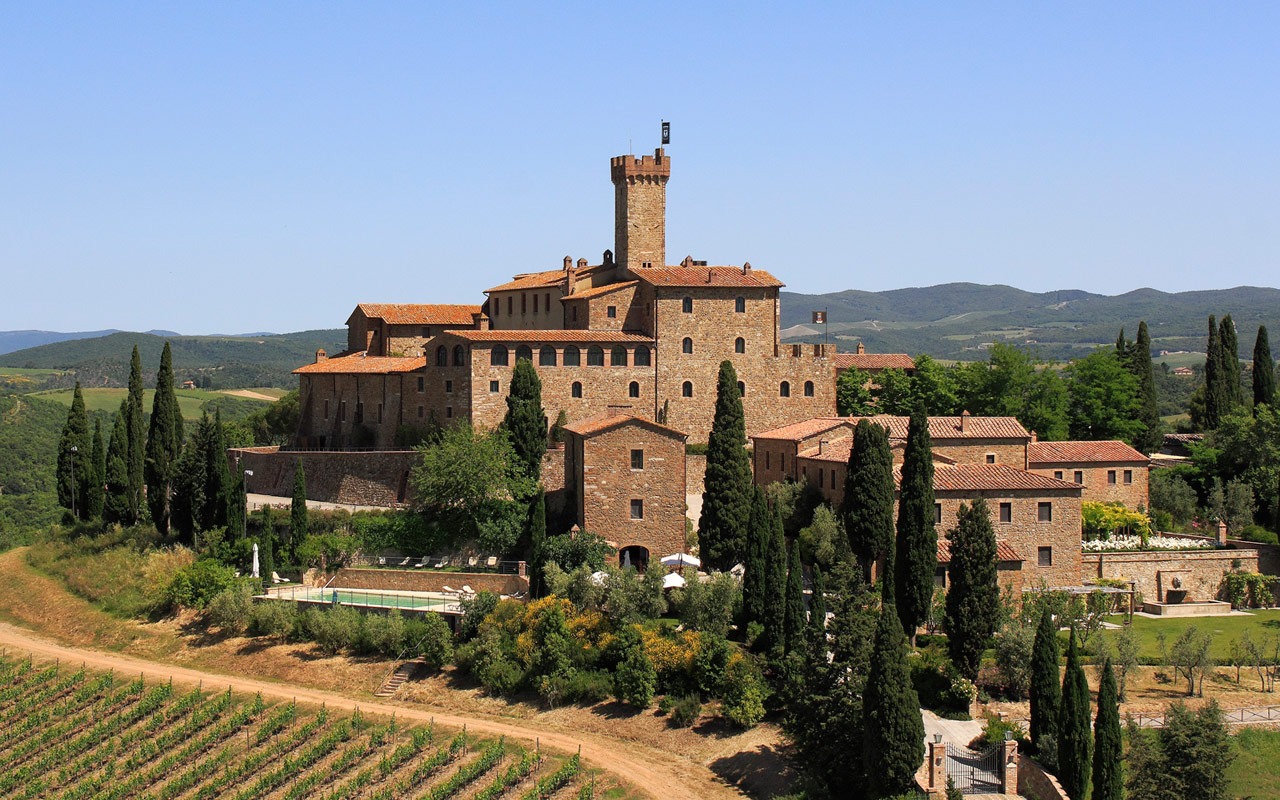 temperature drops at
night, encouraging good acids in the grapes. Also
on hand was wine authority James Suckling, who
commented on the structure of well-blended
Brunellos that have a true elegance owing to the
sangiovese, a grape that grows nowhere else with
any distinction.
temperature drops at
night, encouraging good acids in the grapes. Also
on hand was wine authority James Suckling, who
commented on the structure of well-blended
Brunellos that have a true elegance owing to the
sangiovese, a grape that grows nowhere else with
any distinction.
Banfi has been very much in the
vanguard of modern viniculture, including hybrid
fermentation by which the fresh juice is fermented
in temperature-controlled stainless steel with oak
staves and the oak helps keep a more constant
temperature during the process. The wines are not
filtered and they are bottled under nitrogen. Meanwhile,
the estate’s carbon footprint has been reduced by
plantings of forests and maintaining natural
meadows, while a modern, drip irrigation system
has reduced water consumption by 80%.
At the seminar we tasted 15
wines (below),
the first, from 2013, being barrel samples that
will be blended to make a wine to be released in
2018. The
vintage is expected to be an excellent one, based
on dry weather in April, cooler, dry temperatures
in June, average temperatures through summer, then
a sudden mid-August heat wave that mellowed in
September for a good harvest. Each
sample showed subtle differences in flavor and
body: the wine from the Mandrielle Vineyard was
fruity but very tight, while a Sorrena Vineyard
was tighter still and distinctly tannic. Far more
ripe and very fruity was the wine from Baidaioli
Vineyard, while that from the Poggioni Vineyard
was very rich with an underlying taste of straw
and fennel.
We then turned to the 2010
vintage--said to resemble the highly vaunted
1997--which had mild temperatures in spring and
early summer, followed by heat, then cooling
August nights, culminating in a fairly dry early
autumn. The
alcohol level is 13.9%. It would not be considered
infanticide to drink the Castello Banfi
Brunello di Montalcino 2010 ($65-$75)
right now, for it’s a forward wine with
fast-mellowing tannins.
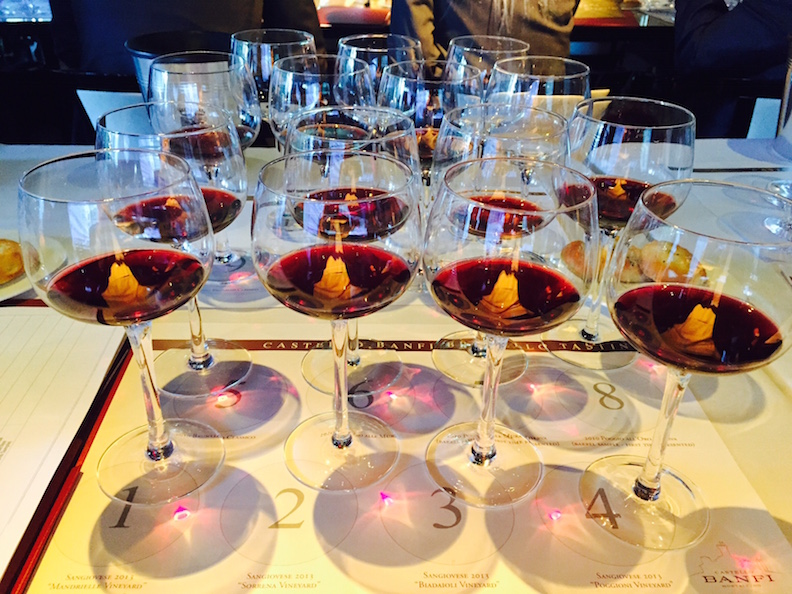 Poggio alle Mura 2010
($70-$75) was more luscious, voluptuous, spicy and
peppery, still coming together in the bottle and
promising a long life of maturity ahead. The same
wine’s Riserva,
which is still aging in wood right now, was very
similar to its sister wine but seemed a little
light, with more finesse at this point. Poggio all’Oro
Riserva 2010, another barrel sample, had
very little bouquet at first but was syrupy on the
palate, lingering long, showing complexity and an
elegant balance of fruit, acid and tannins.
Poggio alle Mura 2010
($70-$75) was more luscious, voluptuous, spicy and
peppery, still coming together in the bottle and
promising a long life of maturity ahead. The same
wine’s Riserva,
which is still aging in wood right now, was very
similar to its sister wine but seemed a little
light, with more finesse at this point. Poggio all’Oro
Riserva 2010, another barrel sample, had
very little bouquet at first but was syrupy on the
palate, lingering long, showing complexity and an
elegant balance of fruit, acid and tannins.
We then moved on to the 2007
vintage, which had an early growing season, heavy
May rainfall and a mid-June heat wave, followed by
ideal fall weather, with harvesting a week ahead
of the usual time.
Banfi says that 2007 marked a year of
innovations by a new micro-winery called
“Horizon,” taking advantage of continuing clonal
research and artisan vineyard management, with
separate vinification of each Brunello on the
property.
The Brunello di Montalcino 2007 ($50-$60),
released in 2012, was wonderfully ripe with plum
fruit flavors but, at 14% alcohol, not at all
cloying. Brunellos
on first whiff may seem slightly oxidized, but
that usually blows off, as it did with this wine,
revealing a very well rounded style. Poggio alle Mura 2007
($55-$80) is still very tannic, but it has a fine
backbone of dark and cherry-like fruits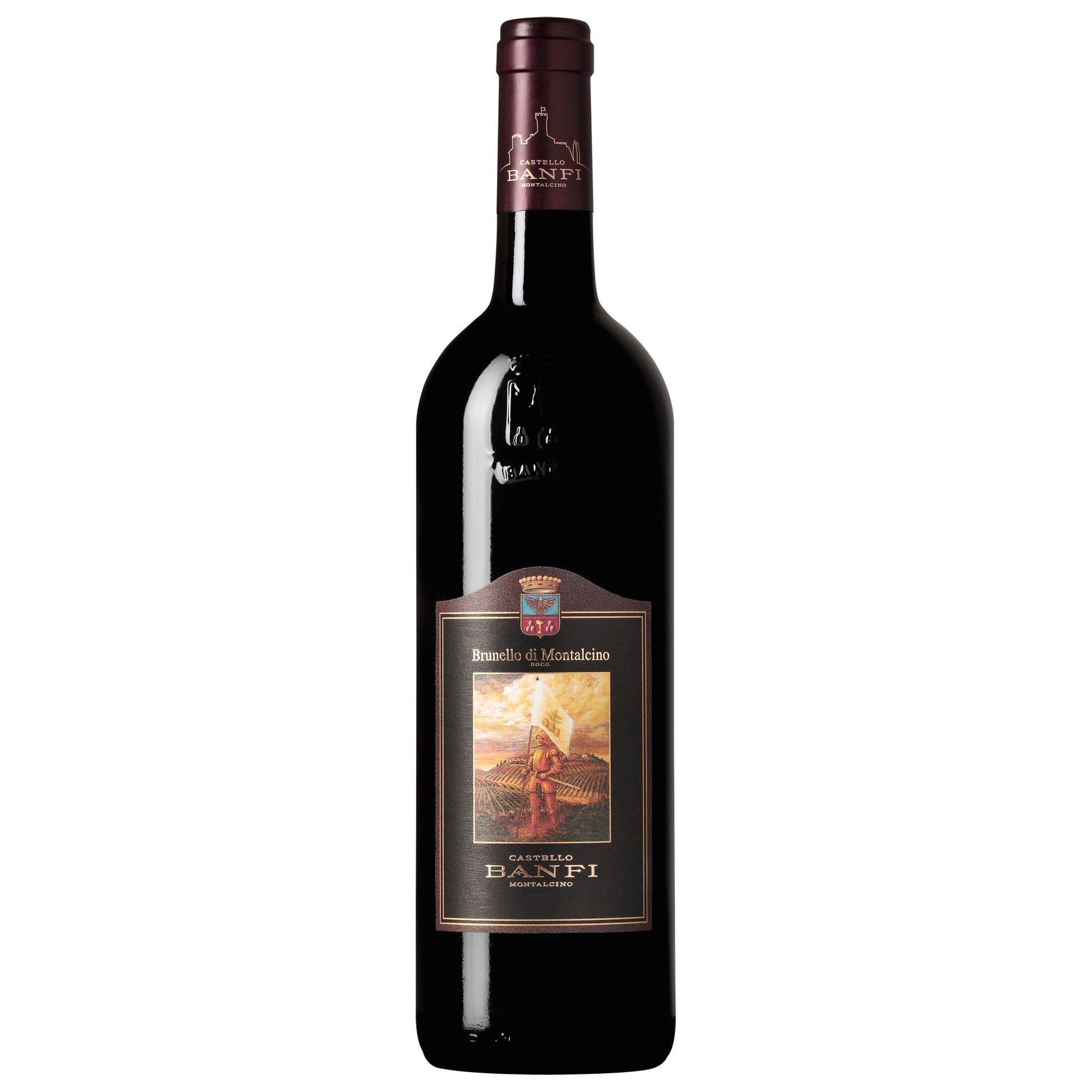 that
should emerge within a year or two.
that
should emerge within a year or two.
The 2007 vintage was a debut
for Poggio alle
Mura Riserva (which I've found in
a range from $85-$150), one of my favorites of the
finished wines, with a resilience of fruit and
acid and a deep complexity with tannins softening
in harmony.
The Poggio
all’Oro 2007 ($130-$170), at 15.2%
alcohol, is a very big wine for an Italian red,
and, while I did not find it particularly tannic
at this point, it did not seem knitted just yet,
leaving a mild bitterness to be resolved.
The riservas
were released in 2013.
We then had a chance to taste
how these wines stacked up next to the much
heralded 1997 vintage, about which I first had
doubts. My early tastings of 1997s did not impress
me then as one of those oft-claimed “wines of the
century,” but after ten years of aging, I found
several of them superb wines on all counts. Indeed
the Castello
Banfi Brunello di Montalcino ($80-$120)
was delicious, nice and loose, the acids in
impeccable trim and the whole of it very fresh on
the palate, with 13% alcohol.
Our table might well have had
an off bottle, because the bouquet of the 1997 Poggio alle Mura
($80-$120) was unpleasantly funky aroma did not
blow off after 30 minutes, though the flavor was
sound if not stunning. The difficult to find Poggio all’Oro
Riserva ($115-$125) was still tight but
indicated at every level that its nutty, violet,
spicy flavors will come together beautifully at
13.2% alcohol.
These distinctions are all part
of the crafting of a wine of Brunello’s eminence,
whose storied past has been respectfully added to
at the Banfi estate. In matters of wine, time
will always tell, but the care taken in blending
makes the odds tilt strongly towards consistent
excellence.
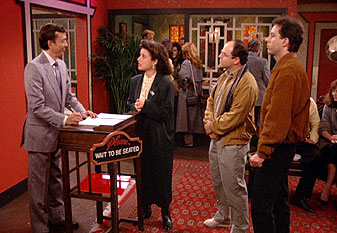
NOSE JOB WHILE YOU WAIT, THEN
FREE CHICKEN AND RICE!
A Korean restaurant in Zhengzou,
China, posted a sign reading "free meal for
good-looking people" as judged by a panel of
plastic surgeons whose practice is advertised on
another restaurant sign.
HOW
TO MAKE WHALE TESTICLE BEER: 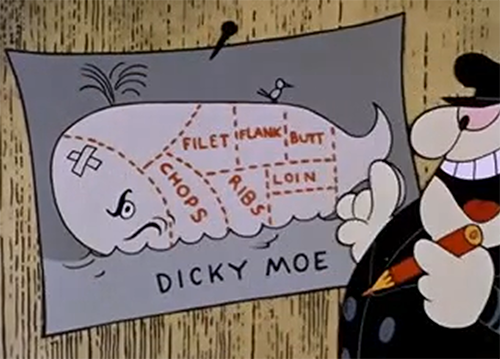
STEP ONE, FIND WHALE; STEP TWO,
GET WHALE VERY DRUNK.
Icelandic brewery Steðji's
Hvalur
2 is now making a whale testicle beer. Co-owner
Dagbjartur Ariliusson says that
they lightly salt and smoke them "according to an
old Icelandic tradition. We put a lot of effort into
this and it's a long process." The beer is meant
to be drunk during the centuries-old festival of
eating cured whale.
Any of John Mariani's books below may be ordered from amazon.com.
 I'm proud and happy to announce that my
new book, The Hound
in Heaven (21st Century Lion Books), has just
been published through Amazon and Kindle.
I'm proud and happy to announce that my
new book, The Hound
in Heaven (21st Century Lion Books), has just
been published through Amazon and Kindle. It is a novella, and for anyone who loves dogs, Christmas, romance, inspiration, even the supernatural, I hope you'll find this to be a treasured favorite. The story concerns how, after a New England teacher, his wife and their two daughters adopt a stray puppy found in their barn in northern Maine, their lives seem full of promise. But when tragedy strikes, their wonderful dog Lazarus and the spirit of Christmas are the only things that may bring back his master back from the edge of despair.
WATCH THE VIDEO!
“What a huge surprise turn this story took! I was completely stunned! I truly enjoyed this book and its message.” – Actress Ali MacGraw
“He had me at Page One. The amount of heart, human insight, soul searching, and deft literary strength that John Mariani pours into this airtight novella is vertigo-inducing. Perhaps ‘wow’ would be the best comment.” – James Dalessandro, author of Bohemian Heart and 1906.
“John Mariani’s Hound in Heaven starts with a well-painted portrayal of an American family, along with the requisite dog. A surprise event flips the action of the novel and captures us for a voyage leading to a hopeful and heart-warming message. A page turning, one sitting read, it’s the perfect antidote for the winter and promotion of holiday celebration.” – Ann Pearlman, author of The Christmas Cookie Club and A Gift for my Sister.
“John Mariani’s concise, achingly beautiful novella pulls a literary rabbit out of a hat – a mash-up of the cosmic and the intimate, the tragic and the heart-warming – a Christmas tale for all ages, and all faiths. Read it to your children, read it to yourself… but read it. Early and often. Highly recommended.” – Jay Bonansinga, New York Times bestselling author of Pinkerton’s War, The Sinking of The Eastland, and The Walking Dead: The Road To Woodbury.
“Amazing things happen when you open your heart to an animal. The Hound in Heaven delivers a powerful story of healing that is forged in the spiritual relationship between a man and his best friend. The book brings a message of hope that can enrich our images of family, love, and loss.” – Dr. Barbara Royal, author of The Royal Treatment.
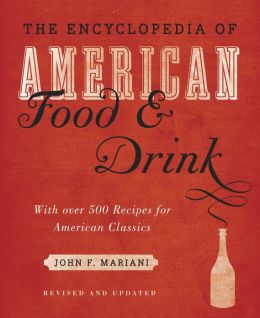 |
The Encyclopedia of American Food and Drink by John F. Mariani (Bloomsbury USA, $35) Modesty forbids me to praise my own new book, but let me proudly say that it is an extensive revision of the 4th edition that appeared more than a decade ago, before locavores, molecular cuisine, modernist cuisine, the Food Network and so much more, now included. Word origins have been completely updated, as have per capita consumption and production stats. Most important, for the first time since publication in the 1980s, the book includes more than 100 biographies of Americans who have changed the way we cook, eat and drink -- from Fannie Farmer and Julia Child to Robert Mondavi and Thomas Keller. "This book is amazing! It has entries for everything from `abalone' to `zwieback,' plus more than 500 recipes for classic American dishes and drinks."--Devra First, The Boston Globe. "Much needed in any kitchen library."--Bon Appetit. |
"Eating Italian will never be the same after reading John Mariani's entertaining and savory gastronomical history of the cuisine of Italy and how it won over appetites worldwide. . . . This book is such a tasteful narrative that it will literally make you hungry for Italian food and arouse your appetite for gastronomical history."--Don Oldenburg, USA Today. "Italian
restaurants--some good, some glitzy--far
outnumber their French rivals. Many of
these establishments are zestfully described
in How Italian Food Conquered the World, an
entertaining and fact-filled chronicle by
food-and-wine correspondent John F.
Mariani."--Aram Bakshian Jr., Wall Street
Journal.
"Equal parts
history, sociology, gastronomy, and just
plain fun, How Italian Food Conquered the
World tells the captivating and delicious
story of the (let's face it) everybody's
favorite cuisine with clarity, verve and
more than one surprise."--Colman Andrews,
editorial director of The Daily
Meal.com. "A fantastic and fascinating
read, covering everything from the influence
of Venice's spice trade to the impact of
Italian immigrants in America and the
evolution of alta cucina. This book will
serve as a terrific resource to anyone
interested in the real story of Italian
food."--Mary Ann Esposito, host of PBS-TV's
Ciao
Italia. "John Mariani has written the
definitive history of how Italians won their
way into our hearts, minds, and
stomachs. It's a story of pleasure over
pomp and taste over technique."--Danny Meyer,
owner of NYC restaurants Union Square
Cafe, The Modern, and Maialino.
|
 |
 |
 |
 |
 |
 |
 |
 |
 Everett Potter's Travel Report:
Everett Potter's Travel Report: 
 Eating Las Vegas
is the new on-line site for Virtual Gourmet
contributor John A. Curtas., who since 1995
has been commenting on the Las Vegas food
scene and reviewing restaurants for Nevada
Public Radio. He is also the
restaurant critic for KLAS TV, Channel 8 in
Las Vegas, and his past reviews can be
accessed at KNPR.org.
Click on the logo below to go directly to
his site.
Eating Las Vegas
is the new on-line site for Virtual Gourmet
contributor John A. Curtas., who since 1995
has been commenting on the Las Vegas food
scene and reviewing restaurants for Nevada
Public Radio. He is also the
restaurant critic for KLAS TV, Channel 8 in
Las Vegas, and his past reviews can be
accessed at KNPR.org.
Click on the logo below to go directly to
his site.

Tennis Resorts Online: A Critical Guide to the World's Best Tennis Resorts and Tennis Camps, published by ROGER COX, who has spent more than two decades writing about tennis travel, including a 17-year stretch for Tennis magazine. He has also written for Arthur Frommer's Budget Travel, New York Magazine, Travel & Leisure, Esquire, Money, USTA Magazine, Men's Journal, and The Robb Report. He has authored two books-The World's Best Tennis Vacations (Stephen Greene Press/Viking Penguin, 1990) and The Best Places to Stay in the Rockies (Houghton Mifflin, 1992 & 1994), and the Melbourne (Australia) chapter to the Wall Street Journal Business Guide to Cities of the Pacific Rim (Fodor's Travel Guides, 1991).


MARIANI'S VIRTUAL GOURMET
NEWSLETTER is published weekly. Editor/Publisher: John
Mariani.
Editor: Walter Bagley. Contributing Writers: Christopher Mariani,
Robert Mariani, Misha
Mariani,
John A. Curtas, Edward Brivio, Mort Hochstein,
Andrew Chalk, Dotty Griffith and Brian Freedman. Contributing
Photographers: Galina Dargery, Bobby
Pirillo. Technical Advisor: Gerry McLoughlin.
To un-subscribe from this newsletter,click here.
© copyright John Mariani 2014

